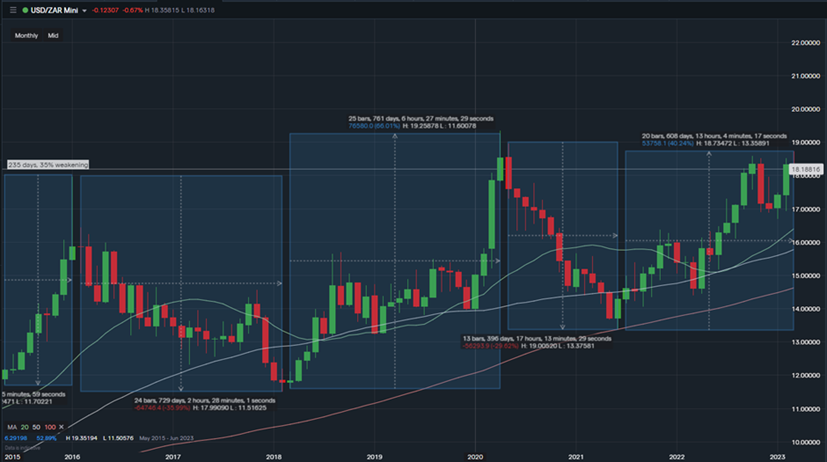We know the Rand is volatile
But….
South Africa’s currency is known for its volatility, we get that.
It experiences frequent and unpredictable changes in value. But it would seem that the unexpected changes in local economic indicators don’t necessarily have a significant impact on the rand’s volatility. Not really anyway. Instead, both domestic and global factors will impact the rand’s volatility. It’s kind of complicated but also really simple.
Let’s illustrate why we say this by listing the various factors that can impact the volatility of the rand –
- global factors such as commodity price volatility and financial market risk perceptions;
- local political uncertainty;
- increased volatility in South Africa’s main exported and imported commodity prices, as well as
- heightened global financial-market risk perceptions,
all contribute to the rand’s instability.
That’s a pretty even spread across the board we’d say.
Further to the above, several varying factors – from both a global and local perspective – determine the drivers of rand volatility. Economic surprises, which involve significant deviations between actual and expected macroeconomic variables, were analyzed using the Citi Bank Economic Surprise Index. The results indicate that US economic surprises have a greater impact on the rand’s volatility compared to South African economic surprises.
Whether it’s local strife or global upheaval, the ripples in the financial waters seem to disrupt the shores of our sunny South Africa irrespective of where the tidal wave comes from.

So, is the rand’s volatility really that important where offshore investments are concerned?
Hold up just a second – where’s the proof?
We are sure you may be in a little bit of disbelief. We know, it seems kind of irresponsible to not consider the rands volatility. But there are several examples that demonstrate the relationship between specific events and changes in rand volatility. And how – in the end – favourable results were achieved regardless.
As an initial example, in November 2016, the rand became the most volatile currency globally following market adjustments triggered by Donald Trump’s unexpected victory in the US presidential elections. How this is related to South Africa all has to do with both trade relations between the countries as well as their political relations – according to the US Department of State, “South Africa is a strategic partner of the United States, with strong collaboration in the areas of health, education, environment, and digital economy”. But this – as we know – can turn on a dime.
As we have recently discovered –
“Foreign Minister Naledi Pandor walked back South Africa’s initial call for Russia to withdraw on the grounds that maintaining that position would be “simplistic and infantile,” even as she defended plans to hold military exercises with Russia and China on the upcoming anniversary of Russia’s invasion, it didn’t read like an effort to avoid tensions between major world powers. It read like an act of solidarity with the Russian government”. (Council on Foreign Relations).
The relationship between the US and South Africa, whilst cordial has had a few chilly (and sometimes unexpected) interactions. For example, in December 2015, the rand depreciated overnight due to the unexpected dismissal of the then Finance Minister Nhlanhla Nene, but then quickly rebounded when former Finance Minister Des Van Rooyen was reappointed.
Conversely, in early 2016, positive news from rating agencies led to a significant overnight gain in the rand’s value.
It can be difficult (but not impossible) to predict and often involves a number of intricate – yet interweaved – details.
And it doesn’t stop with just the above examples. From 2015 all the way to 2022, the rand experienced periods of elevated volatility and relative stability. At times, the rand exhibited significant appreciation against the USD, reflecting positive market sentiment and favourable economic conditions.
However, as with life, what goes up must come down, and the rand’s periods of appreciation were often followed by subsequent pullbacks. That’s foreign exchange for you. To provide a more accurate analysis, let’s consider specific examples of rand volatility and its subsequent pullbacks against the USD dollar:
- 2015-2016: the rand experienced significant weakening against the USD, with its value declining from 11.70 to 18.04. This represented a depreciation of approximately 35%. The rand was adversely affected by various factors, including global economic uncertainties and domestic challenges.
- 2016-2018: the rand showed strength against the USD for a duration of 729 days. Its value appreciated from 17.99 to 11.51, indicating a gain of approximately 35.99%. Positive market sentiment, improved economic conditions, and increased investor confidence contributed to the rand’s strengthening.
- 2018-2020: a considerable weakening of the rand against the USD, lasting for 761 days followed. The rand’s value declined from 11.60 to 19.25, reflecting a depreciation of approximately 66%. This period of volatility can be attributed to the COVID-19 pandemic adding a layer of unpredictability and amplified the existing challenges faced by the rand, emphasizing the importance of monitoring, and understanding the various factors that influence currency volatility.
- 2020-2021: over a span of 396 days, the whole world recovered, and we saw the rand displaying strength against the USD, appreciating from 19 to 13.37. This represented a gain of approximately 42.84%. Positive developments, including improved sentiment towards emerging markets and favorable domestic factors, contributed to the rand’s strengthening during this period.
- 2022: last year the rand experienced a weakening trend against the USD, with its value declining from 13.35 to 18.73. This represented a depreciation of approximately 28.92%.
Clearly, the South African rand has demonstrated a high level of volatility against the USD over the past couple of years. The fluctuations in its value have been driven by various factors such as global economic conditions, commodity price volatility, political uncertainty, and the unexpected impact of the COVID-19 pandemic.
These volatile movements have presented both challenges and opportunities for individuals and businesses engaged in trade and investment. And surprisingly, they have reaped tremendous reward for those who not only partnered with the correct partners (like Kuda FX) but also those who had the foresight to stick with their foreign investment goals and strategies.
So, the question really comes down to this –

Does the volatility of the rand really have an impact on investment decisions?
We repeat ourselves when we say – what comes up must come down. It’s the nature of things. And especially true where foreign exchange is concerned. Even the most prudent investor tries to “time” things perfectly, hoping to capitalise on rand fluctuations for advantageous offshore investment.
Kind of like making hay while the sun shines…
But as we discussed in our article Rand Strength vs Rand Weakness – Should your clients take money offshore now?, to do so is not only futile but unwise.
You see, we have learnt – through years of experience mind you – that trying to time moving rands offshore to gain the best return on investment yields little to no significant advantage. Because trying to time the market often has little bearing on the long-term outcomes of offshore investment strategies.
And it’s clear why – with so many ingredients in what is a complicated recipe, small things can upset the apple cart. And before you know it, timing something incorrectly can leave you with a sunken and burnt Soufflé.
Who wants that?
The South African rand, like all currencies, ebbs and flows in response to various economic factors. It seems almost like a fait accompli – transfer funds offshore when the rand is strong and hope to reap the significant rewards. But then of course the converse would ring true, wouldn’t it? During periods of rand weakness, investment would halt due to fear of diminished returns. And so, the cycle continues ad infinitum, ad nauseum. And that makes very little sense.
As we already set out –
The key concept often missed in these timing strategies is the inherent inverse correlation between Rand strength/weakness and offshore market strength/weakness. Meaning, periods of Rand strength often coincide with offshore market weakness, and vice versa. This relationship significantly balances the long-term impacts of transferring funds during perceived Rand strength or weakness periods.
And that has led us to a pretty obvious conclusion – the outcome over time is very similar, irrespective of whether the funds are taken offshore during periods of rand strength or weakness. This insight, backed by our experience and empirical data, suggests that the decision to invest offshore should be driven by strategic considerations, not short-term currency fluctuations.
Diversification is key. Prudent investment involves considering individual financial goals, risk appetite and personal diversification needs. And one needs to be quite strategic when doing this. Because global markets are not the only deciding factor. They can’t be. With each ebb and flow there would be a knee jerk reaction to do exactly that – react. And reactive investment as opposed to strategic investment is a bad move.
Sure, one needs to understand the intricacies of forex markets to make any measurable gains in their investment portfolios, but we believe that speculating on short-term currency movements is not a sustainable strategy. Instead, one should always adopt a long-term view.
Steady, slow, purposeful, and consistent wins the race. As is trusting in the advice of financial advisors. At Kuda FX, we aim to help clients navigate complicated investment recipes by ensuring that their offshore investments align with their long-term goals, and are not influenced by transient, here today, gone tomorrow market conditions.
With all the above in mind, we encourage you to get in touch with a Kuda FX professional, like our team at Kuda FX who would be happy to explain the above concepts in further detail or provide any other assistance you may require with your specific hedging needs.
In fact, if you have any queries on the information, we have set out above, please feel free to get in touch with us.
At Kuda FX, we have your back!

